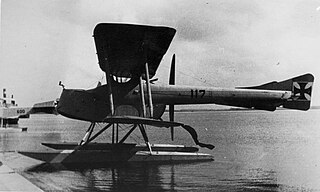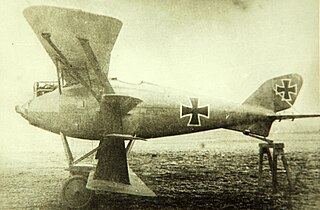
Friedrichshafen FF.33 was a German single-engined reconnaissance three-bay wing structure biplane, using twin floats, designed by Flugzeugbau Friedrichshafen in 1914 for the Marine-Fliegerabteilung aviation forces of the Kaiserliche Marine.

The Friedrichshafen FF.41a was a large, German-built, three-seat, twin-engine floatplane reconnaissance aircraft designed by Flugzeugbau Friedrichshafen in 1917.

Friedrichshafen FF.49 was a German, two-seat, single-engine float-plane designed by Flugzeugbau Friedrichshafen in 1917.

The Friedrichshafen FF.31 was a two-seat prototype German maritime reconnaissance floatplane built by Flugzeugbau Friedrichshafen during the First World War. Although primarily intended for reconnaissance duties, the aircraft was provided with a machine gun to engage other aircraft. Although it was satisfactory for its intended mission, it lacked the performance necessary for use as a fighter. A pair of aircraft were built in 1915 and it was not accepted for production by the Imperial German Navy's Naval Air Service.

The Friedrichshafen FF.34 was a German biplane floatplane of the 1910s produced by Flugzeugbau Friedrichshafen.

The Friedrichshafen FF.40 was a German three-seat floatplane of the 1910s produced by Flugzeugbau Friedrichshafen.
The Friedrichshafen FF.43 was a German single-seat floatplane fighter of the 1910s produced by Flugzeugbau Friedrichshafen.

The Friedrichshafen FF.48 was a German two-seat floatplane fighter of the 1910s produced by Flugzeugbau Friedrichshafen.

The Friedrichshafen FF.53 was a German torpedo-carrying biplane floatplane of the 1910s produced by Flugzeugbau Friedrichshafen.

The Friedrichshafen FF.60 was a German experimental floatplane produced by Flugzeugbau Friedrichshafen.

The Friedrichshafen FF.35 was a German three-seat floatplane torpedo bomber built during World War I by Friedrichshafen Flugzeugbau built for the Imperial German Navy's Naval Air Service. Only one prototype was constructed in 1916 and it saw limited operational use during the war in Courland.
The Friedrichshafen FF.27 was a reconnaissance floatplane built in Germany during World War I.

The Friedrichshafen FF.71 was a German biplane floatplane produced by Flugzeugbau Friedrichshafen.

The Friedrichshafen FF.54 was a German experimental quadruplane that was developed by Flugzeugbau Friedrichshafen during the First World War.

The Friedrichshafen FF.1 was a German experimental floatplane built in 1912. It was the first aircraft designed and built by the newly established Flugzeugbau Friedrichshafen. Only one prototype was constructed and it set a German national record for endurance in 1913 before crashing in early 1914.
The Friedrichshafen FF.2 was a floatplane built in Germany in 1913. It was derived from a design by the Swiss pilot and designer René Grandjean. Only one aircraft was built before the design was reworked into the Friedrichshafen FF.4 the following year.

The Friedrichshafen FF.17 was an experimental floatplane built in Germany in 1914. Originally designed and flown with a single main float and two outriggers as the FF.17, it was later modified as the FF.17b with two floats.

The Friedrichshafen FF.19 was an unarmed maritime reconnaissance floatplane built for the Imperial German Navy's Naval Air Service that was produced by Flugzeugbau Friedrichshafen. Built in small numbers, the aircraft first flew in 1914 and saw service during the early months of World War I, mostly conducting maritime patrols over the North Sea, although they did attack British ships participating in the Raid on Cuxhaven at the end of the year.

The Friedrichshafen FF.63 was a German experimental floatplane produced by Flugzeugbau Friedrichshafen.
The Friedrichshafen FF.67 was a German experimental floatplane produced by Flugzeugbau Friedrichshafen.
















